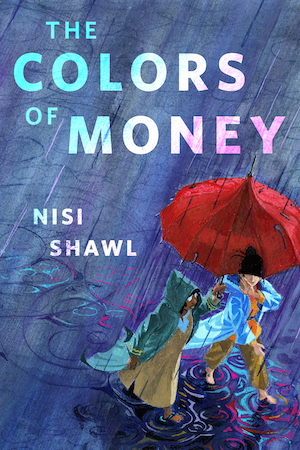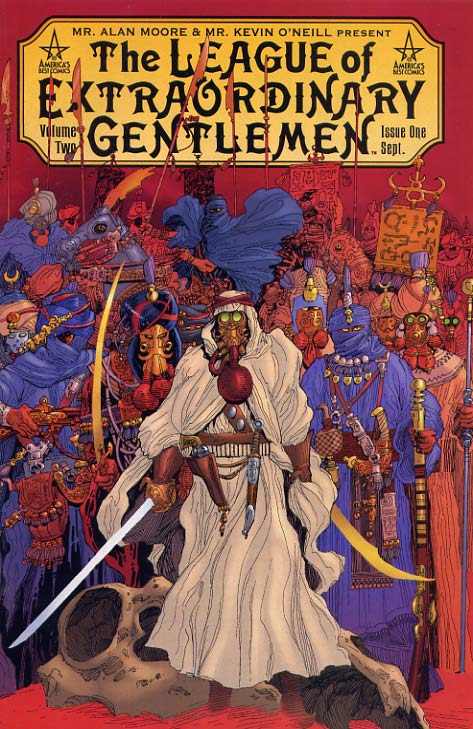Tor.com comics blogger Tim Callahan has dedicated the next twelve months more than a year to a reread of all of the major Alan Moore comics (and plenty of minor ones as well). Each week he will provide commentary on what he’s been reading. Welcome to the 58th installment.
I usually don’t particularly enjoy wordless comics, or they don’t tend to sustain my interest. I can appreciate the artistic displays, but, for me, the power of comics comes from the words colliding with the images. And yet, I think I could read twelve thick collections of a wordless comic featuring Kevin O’Neill’s drawings of Gullivar Jones and John Carter and the Martian wars.
That’s how The League of Extraordinary Gentlemen Volume II begins, with the Martian landscape and Edwin Lester Arnold’s Gullivar Jones and Edgar Rice Burroughs’s John Carter and though it’s not completely wordless, the word balloons are mostly in a Martian dialect that’s not translated on the page for us. Kevin O’Neill draws the heck out of it, and we get massive preparations for war and multi-armed Tharks on armored reptilian battle steeds and the red dunes all around.
All but the final three issues of the first chapter are dedicated to the Martian conflict, as Alan Moore and Kevin O’Neill take their literary gamesmanship to outer space and present a brutal planet filled with characters from not just the relatively obscure Arnold and the well-known Burroughs, but also luminaries such as Michael Moorcock, C. S. Lewis, and H. G. Wells. It’s Wells that provides the major conflict for this second League volume, with his War of the Worlds as the centerpiece. The Martians have arrived, on their terrible tripods with their blazing death rays, and who on Earth can possibly stand in their way?
Well, the members of the League, obviously, but not in the way you might expect.
The League of Extraordinary Gentlemen Volume II#1-6 (Wildstorm/America’s Best Comics, Sept. 2002-Nov. 2003)
With the team already assembled, under new management that’s not much different than the old management—Campion Bond is still their liaison with British Intelligence, even if a less corrupt boss in the form of Sherlock Holmes’s older brother is the new Bondian “M”—this second League of Extraordinary Gentlemen volume gets into the action right away, and that makes for a more exhilarating reading experience from beginning to end.
The threat of a Martian invasion helps to provide a clear external conflict throughout, while Moore and O’Neill explore the character relationships even further than they could in the first volume, and instead of merely giving us six issues of Victorian literary characters fighting Martian tripod death rays, the creative team weaves a substantial Island of Dr. Moreau subplot into the narrative tapestry and includes Lord Tennyson’s “Nature, red in tooth and claw” line as the metaphorical underpinning for the entire miniseries.
If you recall your Tennyson, you’ll remember that in his great poem “In Memoriam A.H.H.”—written as an elegy to the poet Arthur Henry Hallam—Tennyson explores the struggle of humanity in a world in which the beneficence of God and the violence of nature seem to coexist. Tennyson was supposedly influenced by the new ideas about evolution that were beginning to gain popularity in the Victorian age, even decades before Charles Darwin would publish The Origin of the Species. That collision between science and faith, and a parallel dichotomy between savagery and decorum, inform League Volume II, and while the brutal Martians attack and the heroes give in to many of their more primal, lusty instincts, who could be a more appropriate foil than H. G. Wells’s Dr. Moreau, a scientist who sews together humans and animals into ungodly beasts?
That was a rhetorical question, obviously, because Dr. Moreau, as depicted by Moore and O’Neill is not just a plot device—helping to defeat the Martians with a particularly nasty hybrid he’s concocted—but he’s also the embodiment of the Victorian inner conflict. His hybrids are monstrosities, but they are built through science, and he requires them to wear appropriate clothes, even as their claws rip through the nice shoes and they beat each other when they forget to walk on two legs instead of four. His cartoonish animal minions are horrifying and tragic, and Moore and O’Neill pull their visual representations from old British comics and The Wind and the Willows, making their presence all the more disturbing, with the echoes of childhood vibrating through the pages.
Moreau, as a character, barely appears on panel in the miniseries—for about eight pages total—but he, and everything he represents, is at the core of the story.
That isn’t to say that all the non-Moreau parts of The League Volume II are inessential, because Moore and O’Neill pack these six issues with memorable scenes, but if you were to draw a Venn diagram of all the ways in which the themes and metaphors and symbols intersect, Moreau would be at the center.
So what are some of the other memorable scenes?
Besides the opening sequence on Mars—as I said, worthy of expansion into entire volumes of the Continuing Adventures of Gullivar and John Carter in Space—we get the terrifyingly Victorian moment of disbelief and good intentions and tragic outcomes when the first human emissaries attempt to make contact with the Martians that have crashed near London. If you’ve ever seen the 1953 George-Pal-produced War of the Worlds, you’ll probably remember the bit where the death rays start shooting out and the bystanders become vaporized thanks to flickering special effects. Moore and O’Neill present a far more gruesome version of that event, as the bystanders burn and the members of the League flee for their lives.
Moore and O’Neill also give us a pair of scenes in which Mr. Hyde’s character is further developed: one in which the giant beast expresses his confusion about how he feels toward Mina Murray, but knows that he wants to rape her and yet protect her from himself, and another in which he takes cruel revenge against the betrayal of the Invisible Man. These scenes are beyond morally troubling, and in a comic like The League of Extraordinary Gentlemen, which has a steady layer of playful wit, the actions of both the Invisible Man and Mr. Hyde play out like plague-infected rusty daggers right into the lungs of the reader. It’s painful stuff to read, and it can knock the wind out of you, but it certainly gets your attention and lets you know that there’s some deadly serious stuff in this comic, and the fun and games can turn horrific in a second.
In general, the horror-to-comedy ratio is much more in favor of horror in this volume, particularly compared to the first series, but it still maintains its intelligence and sense of irony, no matter how dark.
Allan Quatermain and Mina Murray also deepen their relationship, emotionally and physically, and while they are the only two members of the team left standing in the end—well, Nemo survives, but he’s off in an iron fish of his own—they end up alone. Mina leaves Quatermain so she can go off and make sense out of everything she’s been through, and the old man sits by himself on the park bench as the leaves fall off the trees around him. No celebrations this time.
But that’s the end, and I didn’t yet talk about how the good guys (such as they are) defeated the bad guys (who are really bad, because they are world-killing Martian monsters, for crying out loud). In the H. G. Wells novel, the Martians ultimately die of bacterial infection, because they have no resistance to Earth bacteria. In The League of Extraordinary Gentlemen Volume II, the same thing happens, but not passively. The hybrid the government obtained from Dr. Moreau was no simple mix of man and animal. It was Hybrid-142, a mix of anthrax and streptococcus. Biological warfare, launched via cannon into the heart of the Martian invasion.
“There must still be people in south London!” shouts Mina Murray to Campion Bond. He replies, “Officially, the Martians died of the common cold. Any humans died of Martians.”
The anti-colonialist Nemo strides away, refusing to work with the League ever again. The Invisible Man and Hyde are dead. It’s just Mina and Quatermain in the final scene, and they don’t last another page without separating for good.
Or, at least until the next volume, when the story picks up again. Only, it can’t be that easy, can it? Not when Alan Moore and Kevin O’Neill are involved.
NEXT TIME: A sourcebook becomes a postmodern mélange in The League of Extraordinary Gentlemen: The Black Dossier.
Tim Callahan writes about comics for Tor.com, Comic Book Resources, and Back Issue magazine. Follow him on Twitter.










